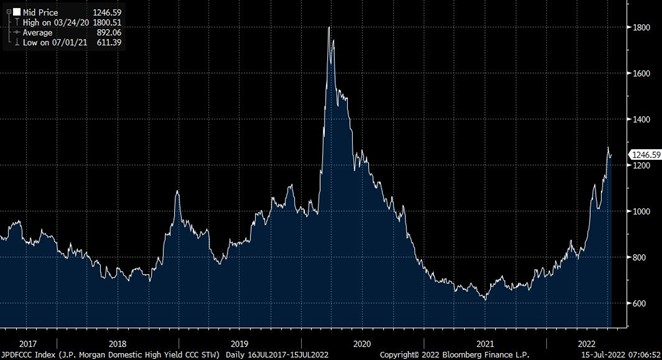Lower-rated credit was an outperformer within the high-yield market during the first quarter 0f 2022, as Treasury rates rose rapidly and investors rotated out of longer-duration BB securities. As the second quarter began, however, growth concerns started to emerge and recession probabilities increased. By June, a technical recession was almost assured and the debate shifted to how deep and how long the downturn would be.
As this week’s chart shows, CCC spreads widened dramatically in June and have now eclipsed the levels from December 2018, which was at the tail end of the previous Federal Reserve (Fed) hiking cycle and balance sheet reduction, by over 150 basis points (bps). The difference now is that we are earlier in the process and it’s not clear when the next Fed pivot (to become more dovish) will occur. The consensus is to continue to buy higher-quality and more-liquid securities, and I agree. Still, valuations are starting to look interesting, and I believe it’s always a good strategy to line up buy candidates when sentiment and positioning are poor.
The portion of the market rated in the CCC category has shrunk considerably over the last 10 years to 10-15%, depending on the index. Overall index quality improved post-2008 as the amount of leveraged buyout (LBO) activity and leveraged recapitalizations declined. More recently, the large wave of COVID-19 downgrades from investment-grade status into high yield largely settled in the BB category, which further improved the high yield asset mix.
2021 saw a resurgence in LBO deals and a large number of new senior and unsecured bonds entered the market. Performance was strong at the outset but many now face weaker growth prospects and intense margin pressure. Moreover, many CCC-rated companies have large amounts of floating-rate bank debt that is being repriced higher and will take a bite out of free-cash-flow levels. On the positive side, a number of 2019-2021 LBOs have strong business models, no near-term maturities, moderate capex requirements and fairly well-defined valuation parameters.
Key Takeaway
While referring to the CCC category is appropriate when classifying risk, I don’t view it as a distinct sub-asset class because it’s so idiosyncratic. It is safe to say that CCC credit tends to be illiquid, particularly in bull and bear markets. You can’t buy it or sell it at any size when you want, at least at prices that seem reasonable. With the group breaching the 1200 bps threshold over Treasuries, and may move wider with a lousy Q2 earnings season and a pipeline of pending deals that need to clear the market, I am preparing to add risk selectively. Similar to my philosophy on appointments and meetings, it’s often better to be an hour early than 15 minutes late.
The material provided here is for informational use only. The views expressed are those of the author, and do not necessarily reflect the views of Penn Mutual Asset Management.
This material is for informational use only. The views expressed are those of the author, and do not necessarily reflect the views of Penn Mutual Asset Management. This material is not intended to be relied upon as a forecast, research or investment advice, and it is not a recommendation, offer or solicitation to buy or sell any securities or to adopt any investment strategy.
Opinions and statements of financial market trends that are based on current market conditions constitute judgment of the author and are subject to change without notice. The information and opinions contained in this material are derived from sources deemed to be reliable but should not be assumed to be accurate or complete. Statements that reflect projections or expectations of future financial or economic performance of the markets may be considered forward-looking statements. Actual results may differ significantly. Any forecasts contained in this material are based on various estimates and assumptions, and there can be no assurance that such estimates or assumptions will prove accurate.
Investing involves risk, including possible loss of principal. Past performance is no guarantee of future results. All information referenced in preparation of this material has been obtained from sources believed to be reliable, but accuracy and completeness are not guaranteed. There is no representation or warranty as to the accuracy of the information and Penn Mutual Asset Management shall have no liability for decisions based upon such information.
High-Yield bonds are subject to greater fluctuations in value and risk of loss of income and principal. Investing in higher yielding, lower rated corporate bonds have a greater risk of price fluctuations and loss of principal and income than U.S. Treasury bonds and bills. Government securities offer a higher degree of safety and are guaranteed as to the timely payment of principal and interest if held to maturity.
All trademarks are the property of their respective owners. This material may not be reproduced in whole or in part in any form, or referred to in any other publication, without express written permission.


